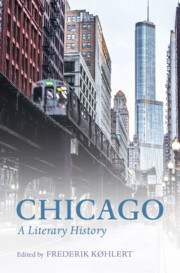Book contents
- Chicago: A Literary History
- Chicago
- Copyright page
- Contents
- Figures
- Contributors
- Acknowledgments
- Introduction: The Literary History of Chicago
- Part I The Rise of Chicago and the Literary West
- Chapter 1 From Prairie to Metropolis: Chicago as the American “Shock City”
- Chapter 2 Birth, Fire, and Rebirth: Edward Payson Roe’s Barriers Burned Away and the Invention of Chicago Literature
- Chapter 3 “This Broad, Free Inland America of Ours”: Hamlin Garland, Chicago, and the Literary West
- Chapter 4 White City: The World’s Columbian Exposition in Literature
- Chapter 5 New Realities, New Realisms: Chicago Literature against the Genteel Tradition
- Part II Business Unusual: A New Urban American Literature
- Part III Radicalism, Modernism, and the Chicago Renaissance
- Part IV A City of Neighborhoods: The Great Depression, Sociology, and the Black Chicago Renaissance
- Part V Traditions and Futures: Contemporary Chicago Literatures
- Selected Bibliography
- Index
Chapter 1 - From Prairie to Metropolis: Chicago as the American “Shock City”
from Part I - The Rise of Chicago and the Literary West
Published online by Cambridge University Press: 02 September 2021
- Chicago: A Literary History
- Chicago
- Copyright page
- Contents
- Figures
- Contributors
- Acknowledgments
- Introduction: The Literary History of Chicago
- Part I The Rise of Chicago and the Literary West
- Chapter 1 From Prairie to Metropolis: Chicago as the American “Shock City”
- Chapter 2 Birth, Fire, and Rebirth: Edward Payson Roe’s Barriers Burned Away and the Invention of Chicago Literature
- Chapter 3 “This Broad, Free Inland America of Ours”: Hamlin Garland, Chicago, and the Literary West
- Chapter 4 White City: The World’s Columbian Exposition in Literature
- Chapter 5 New Realities, New Realisms: Chicago Literature against the Genteel Tradition
- Part II Business Unusual: A New Urban American Literature
- Part III Radicalism, Modernism, and the Chicago Renaissance
- Part IV A City of Neighborhoods: The Great Depression, Sociology, and the Black Chicago Renaissance
- Part V Traditions and Futures: Contemporary Chicago Literatures
- Selected Bibliography
- Index
Summary
This chapter analyzes how turn-of-the-twentieth-century Chicago fiction responded to rapid urbanization. Chicago qualified as what Asa Briggs has called a “shock city”: it embodied the disruption of the Industrial Revolution. The city challenged the nineteenth-century pastoralist view of the American republic because it rose in just a few decades from the Midwestern heartland. Chicago’s urban novelty triggered a reconfiguration of American fiction as writers grappled with a social reality resisting nineteenth-century literary codes. Two varieties of Chicago fiction – realist novels of manners (Henry Blake Fuller; Robert Herrick) and urban naturalism (Theodore Dreiser; Frank Norris; Upton Sinclair) – negotiated this cultural change. The former perpetuated the formula of domestic fiction in a context where the kinship-based knowable community was threatened by economic forces undermining its foundation. The latter sought to represent the new economic determinants through discourses relying on nature romanticism and the gothic. The shift from novels of manners to naturalism produced a new literary topography of the urban world, marking the transition from realism to modernism.
- Type
- Chapter
- Information
- ChicagoA Literary History, pp. 17 - 30Publisher: Cambridge University PressPrint publication year: 2021

